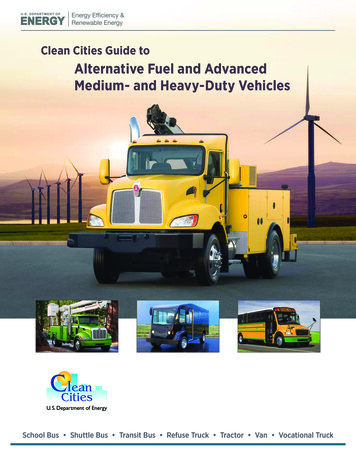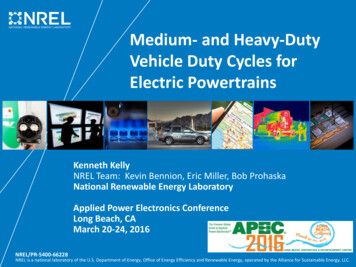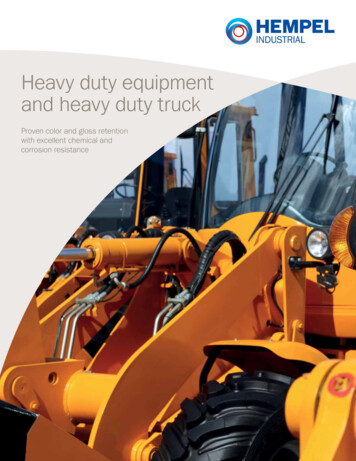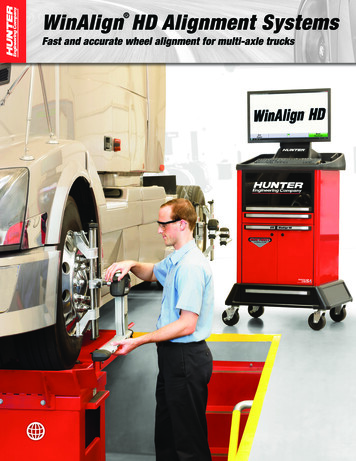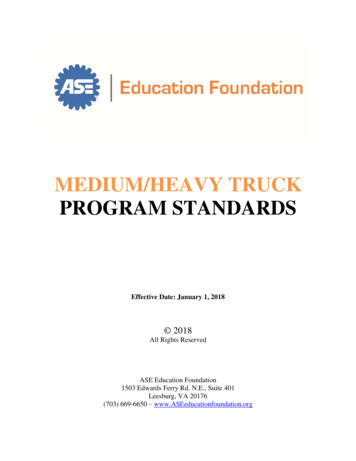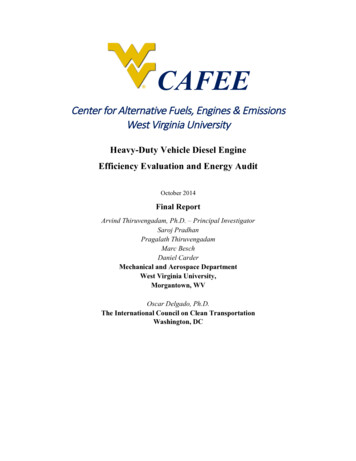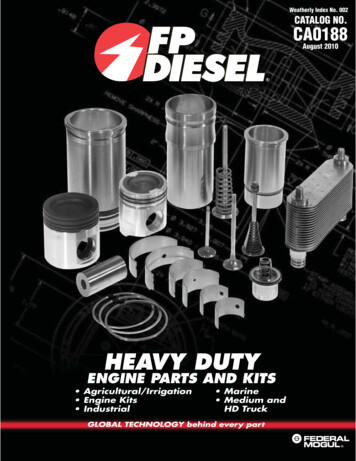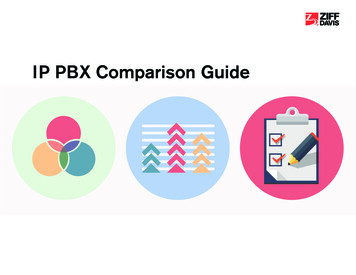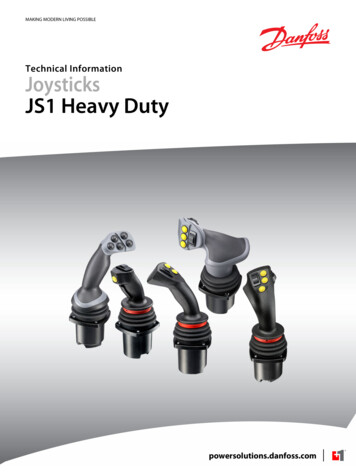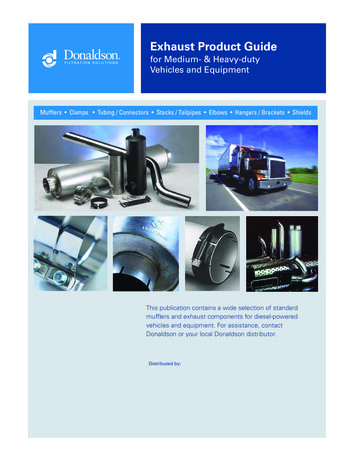
Transcription
Exhaust Product Guidefor Medium- & Heavy-dutyVehicles and EquipmentMufflers Clamps Tubing / Connectors Stacks / Tailpipes Elbows Hangers / Brackets ShieldsThis publication contains a wide selection of standardmufflers and exhaust components for diesel-poweredvehicles and equipment. For assistance, contactDonaldson or your local Donaldson distributor.Distributed by:
Exhaust Product GuideTable of ContentsThis publication contains a wideselection of standard exhaustcomponents for diesel-poweredvehicles and equipment.Donaldson has the technicalexpertise, superior customer supportand vast network of locations aroundthe world to meet your toughestneeds – from initial system designthrough replacement products.For assistance with muffler oraccessory selection, contact yourlocal Donaldson distributor or dealer.Overview. 2Exhaust Product Line .2History.4Engine Exhaust Flow & Airflow Calculations.6Engine Aftermarket Exhaust Warranty.7Shoptalk. 9Purpose of an Exhaust System. 10Muffler Design & Performance . 10Exhaust Product Materials.12Noise Sources. 13Reduce Exhaust Noise. 13Familiar Sounds on the dBA Noise Scale. 13Noise Rules of Thumb. 13E.P.A. Truck Noise Regulations. 14Emissions Devices & Acoustic Silencing. 14Diesel Particulate Matter (PM) Allowedper Horsepower-Hour (soot vials).15Emissions Mandates & Timing.15SealClamp Installation Instructions. 16Cutting & Installation Instructionsfor Flex Tubing. 18Donaldson & Industry Acronyms. 19Engine Brake & Exhaust Silencer. 19Terms & Definitions. 20Accessories. 21Exhaust System Components. 22Common System Configurations. 23Exhaust Joint/Connections. 24Exhaust Clamp Performance Rankings. 25Muffler Body Band Clamps. 29Heat Sleeves & Heat Wraps. 30Flex Tubing & Cut to Length Flex. 30V-Band Clamps. 32Flared Connectors & Adapters. 33Marmon Flange & Flares. 33Reducers/Expanders. 34Connectors. 34Tilt Cab Ball & Cone Connectors. 35Y or Wye Adapter Pipe. 35Splitter Tee Adapter. 35Stack Caps. 36Universal Swivel Hanger. 36Universal Mounting Bracket. 36Pipe Hangers. 36Muffler Guards & Accessories. 37Muffler Hangers. 37Heavy-Duty Muffler Mounting Straps. 37Heavy-Duty Hangers. 38Grab Handle. 40Manifold Tube/Flange. 40Threaded Adapters. 40Universal Pipe Guards & Clamps.41Elbows & Bent Tubes.41Stack Pipes.44Tailpipes. 47Spark Arrestors. 48Exhaust Ejectors & Check Valves. 49Intake Accessories. 51Muffler Selection & Specifications. 65Muffler Selection by Style with AttenuationRanges & Exhaust Flow. 67Muffler Specifications by Part Number. 72Muffler Specifications by Style & Inlet. 79Truck Engine Muffler Application. 87Caterpillar. 88Cummins. 98Detroit Diesel.108International. 114Mack. 119Cross Reference. 125Manufacturers’ Code Listing.1250-9.128A-Z.162Engine Air & Exhaust Flow Guide. 173Part Number Index. 181donaldson.comExhaust Product Guide 1
Exhaust Product Line OverviewOVERVIEWMufflers, Characteristics and ReplacementsFeatures and Benefits ofDonaldson MufflersLow BackpressureBetter fuel economy and efficientengine performanceAluminized SteelDelivers long service life andis corrosion resistantLightweight ConstructionMinimizes stress and vibrationon mounting systemDonaldson MufflersDonaldson exhaust systems are original equipment on mostpre-2007 medium- and heavy-duty trucks manufactured in NorthAmerica. Donaldson engineers work with many OE truck andoff-road equipment manufacturers to design and build qualityexhaust systems to meet specific performance requirements.Truck Mufflers for Every BudgetBEST 1 million mile warranty on M101158 –stainless steel Silent Partner 500,000 mile warranty on M101181 –aluminized steel Silent Partner Superior acoustic performance –specifically addresses engine brakenoise by silencing engine brake “bark”BETTER M100580 Donaldson muffler Meets all OEM back pressure,strength and life requirements Better acoustic performance than theM100465 mufflerGOOD The M100465 is the most common,most popular service muffler in theindustry Low back pressure provides goodfuel economy and efficient engineperformancePart No. M101158 & M101181High Temperature Paint(Available on select product)Paint adds corrosion resistance andenhanced finishPart No. M100580Part No. M100465What external characteristics differentiate mufflers? Shape of muffler (generally round or oval) Style (inlet/outlet configurations on the muffler) MaterialsWhat internal characteristics differentiate mufflers? Wrapped (with insulation) or unwrapped Insulation sandwiched between inner and outer body- Reduces noise/high frequency- Lowers outer shell temperature- Reduces radiated heat Quantity, size, and position of internal baffles and tubesInternalHeat &NoiseOuter Wrap2 Exhaust Product Guidedonaldson.com
Exhaust Product Line OverviewMaterials, Muffler Styles and Exhaust System ConfigurationsOVERVIEWExhaust Product MaterialsA number of different materials are foundin exhaust systems. Often different optionsare available for use in a single application.Since materials vary in strength, corrosionresistance and price, a particular materialmay be preferred in certain applications.Some of the most common materials, theirqualities and their typical uses are listed inthe table on the right.Materials*Used inAluminized MildSteelMufflersStainless SteelFlexible Tubing(with and withoutaluminized coating)QualitiesGood Corrosion ResistanceExhaust ComponentsMufflersStrongerExcellent Corrosion ResistanceExhaust ComponentsEmissions ProductsChromeAccessoriesBright Mirror FinishGalvanizedFlexible TubingLow Material CostTemperature Limit 600 FCold RolledAccessoriesPoor Corrosion ResistanceLow CostMuffler StylesStyle 1End InletEnd OutletOn CenterStyle 4End InletSide OutletStyle 2End InletEnd OutletOffsetStyle 5Inlet & OutletOn Same EndStyle 2ADual End InletEnd OutletStyle 6Side InletSide OutletStyle 3Side InletEnd OutletExhaust System Configurations --------------------------- Styles 1 and 2 --------------------------- donaldson.com ------ Style 3 ----- ------ Style 4 ------ --------- Style 5 -------- ----- Style 6 ----- Exhaust Product Guide 3
History of InnovationOVERVIEWFrom Silencing to Emissions Reduction1950sWhen exhaust was about silencing -- we led the way!Frank Donaldson sold enough mufflers in 1951 to openour first exhaust manufacturing facility in Grinnell, Iowa in1952.1960sIn the 1960s, sound meters were used to measure noise levels (see image above).Donaldson is one of the first manufacturers to introduce the use of aluminized steel inexhaust systems.1970sDonaldson introduces mufflers with integrated ejectors andwrapped mufflers. Wrapped mufflers reduced the overallexhaust system noise and the exterior body temperature.Donaldson SealClamp band-style exhaust clamp launchedinto the marketplace. Donaldson expands to Japan. In 1973,U.S. noise regulations went into effect for on-road vehicles– Donaldson offers a muffler line that was effective at noisereduction without loss of horsepower.1980sIn 1981, Donaldson opens a new technical center.The center included two anechoic chambers whichexpanded our technical capabilities. Mufflers meet1988 U.S. EPA truck noise regulations (sonic chokesand floating baffles).4 Exhaust Product Guidedonaldson.com
History of InnovationFrom Silencing to Emissions ReductionOVERVIEW1990sWhen engine manufacturers needed help to meet the first U.S. Emissions regulations,innovations continued. In the early 1990s, we pioneered the design of integrated catalyticconverter mufflers and diesel particulate solutions for three major U.S. engine and truckmanufacturers. In the late 1990s, Silent Partner was the first muffler that effectivelyreduced engine brake noise without loss of power or fuel economy. During this decade,Donaldson expands exhaust manufacturing in Europe (France); Mexico (Guadalajara); andthe United States (Alabama).2000s2001Donaldson forms a group dedicated to emissions reduction efforts for diesel engines;Spiracle crankcase filtration introduced to eliminate emissions from open crankcasevents. Mass production of CCMs for on-road OEs begins.2002First company to verify tailpipe and crankcase solution(patented).2003Donaldson expands exhaust manufacturing inAguascalientes, Mexico.20042006Donaldson upgrades and expands heavy-duty enginetest cell capabilities; U.S. MSHA accepts Donaldsonhigh temp exhaust filter.Donaldson expands European emissions staffand Mexico exhaust manufacturing to Monterrey;Donaldson improves Stepped SealClamp .Since the early 1990s,Donaldson has soldmore than a millionDOC Mufflers.2007Donaldson expands OE emissions support with production of active and passiveexhaust aftertreatment systems to meet U.S. EPA 2007 on-road emissions regulations.2009Donaldson produces urea and non-urea based NOx reduction systems for OE2010 vehicles.donaldson.comExhaust Product Guide 5
OVERVIEWEngine Exhaust Flow Rate& Airflow CalculationsEngine Exhaust Flow Rate CalculationThe calculations on theright are provided as areference and may behelpful as you validate andselect Donaldson mufflersand components.For the most accurateengine airflow and exhaustflow rates, Donaldsonrecommends using theinformation supplied byyour engine xhaustFlow Reference Section ofthis catalog, page 173.Airflow guide should onlybe used as a referencedocument. For propermuffler application, lookto your engine supplierfor the most accurate andcurrent information.Exhaust flow rate may be calculated using the following formula.()Exhaust Temp. ( F) 460540x Intake Airflow(CFM)Exhaust FlowExhaust temperature and intake airflow rate must be determinedto calculate the exhaust flow rate. Exhaust temperature andmanufacturers maximum backpressure may be approximated usingthe table below.Engine TypeDiesel 2-Cycle Naturally AspiratedDiesel 2-Cycle TurboDiesel 4-Cycle Naturally AspiratedDiesel 4-Cycle TurboGasoline (all types)EngineTemperatureMaximumBackpressure 900º F 750º F 1000º F 900º F 1200º F4" Hg3" Hg3" Hg3" Hg 4" HgNote: If you are spec’ing a dual muffler system, remember to divide engine’s exhaustflow (CFM) by twoEngine Airflow CalculationCFM intake rate is available from the engine manufacturer. If CFMspecifications are not available, use the volumetric efficiencycalculation. A simple calculation for CFM is to multiple thehorsepower of your engine by 2.5.4-Cycle Engine Airflow Calculation()Engine Size (CID) x RPM3456xVolumetricEfficiency Intake Airflow(CFM) Intake Airflow(CFM)2-Cycle Engine Airflow Calculation)(Engine Size (CID) x gine volumetric efficiency ratings are best obtained from yourengine manufacturer. Engines operating with electronic controlscould have volumetric efficiency ratings of more than 2.0. Airflowon these engines should be verified by the engine manufacturer.4 Cycle GAS EngineNaturally Aspirated .70 - .802 and 4 Cycle DIESEL EngineNaturally AspiratedTurbo* .901.50 - 3.00** If VE rating is not available, Donaldson recommends using thehighest value to insure proper airflow.6 Exhaust Product Guidedonaldson.com
Engine AftermarketExhaust WarrantyOVERVIEWThe information below is the exhaust portion of our Engine AftermarketFiltration & Exhaust Warranty Document: F110064Warranty CoverageDonaldson warrants its Aftermarket products againstfailure due to defects in materials and workmanshipfor the period specified under Terms and Conditionsfor the particular product. Donaldson’s obligationunder this warranty covers replacing the failedproduct, including transportation charges, only.If the Donaldson product failure is the sole anddirect cause of damage to the equipment on whichthe product was properly installed, Donaldsonwill reimburse reasonable costs to restore theequipment to the condition it was in immediatelybefore the failure. This warranty does not coverfailure due to misapplication, misuse, abuse,neglect, rust through and corrosion (mufflers),improper installation, improper service practices ornon-Donaldson approved modifications.Engine and equipment manufacturers warrantiesremain in effect when Donaldson products are used.NotificationDonaldson must be notified in writing of any claimscovered by this warranty within one year of the dateof failure. Donaldson, at its discretion, will eitherphysically visit the site where the alleged failure hasbeen found; or, request that all parts (Donaldson andother relevant parts) be shipped prepaid to its GeneralOffice, in care of the Product Lab or as otherwisespecified.Terms and ConditionsWarranty coverage begins on the date and mileagethe product is purchased by the user and expireswhen the specified number of years or miles haspassed, whichever occurs first.The length of warranty for replacement productsprovided under warranty coverage is the balance ofthe warranty period remaining on the product beingreplaced.Warranty Length by Product TypeExhaust ProductsWarranty from Date of Delivery to UserDiesel MufflersVertical InstallationHorizontal Installation4 years or 500,000 miles (800,000 km)3 years or 500,000 miles (800,000 km)Gas Mufflers1 yearSilent Partner Exhaust SilencerStainless SteelAluminized SteelExhaust AccessoriesChrome Parts (peeling and blistering only)Flex PipeLong-Life Flex Pipedonaldson.com8 years or 1,000,000 miles (1,6000,000 km)4 years or 500,000 miles (800,000 km)1 year1 year or 100,000 miles (160,000 km)90 days1 year or 120,000 miles (200,000 km); on-highway use onlyExhaust Product Guide 7
ShoptalkGeneral Exhaust Facts, Maintenance Tips and Product FeaturesSHOPTALKSection IndexPurpose of an Exhaust System. 10Muffler Design & Performance . 10Exhaust Product Materials. 12Noise Sources. 13Reduce Exhaust Noise. 13Familiar Sounds on the dBA Noise Scale. 13Noise Rules of Thumb. 13E.P.A. Truck Noise Regulations. 14Emissions Devices & Acoustic Silencing. 14Diesel Particulate Matter (PM) Allowedper Horsepower-Hour (soot vials). 15Emissions Mandates & Timing. 15SealClamp Installation InstructionsFlat Band Style. 16Stepped Preformed Style. 17Cutting & Installation Instructionsfor Flex Tubing. 18Donaldson & Industry Acronyms. 19Engine Brake & Exhaust Silencer. 19Terms & Definitions. 20donaldson.comExhaust Product Guide 9
ShoptalkSHOPTALKGeneral Exhaust Facts, Maintenance Tips and Product FeaturesPurpose of an Exhaust SystemExhaust system design specifications are typically defined by the OEs. They are looking for a solution that can redirect engineexhaust, reduce exhaust noise and most recently, reduce emissions (hydrocarbons, carbon monoxide, soluble organic fraction (SOF)).Diesel engines are a reliable and efficient power source for vehicle and equipment manufacturers. Governmental regulations acrossthe globe are driving diesel engine users to consider buying new vehicles to meet the new emissions regulations.Muffler Design & PerformanceDonaldson mufflers are designed and tested with specific focuson three performance variables: attenuation, backpressure andstructural.AttenuationFor exhaust systems, attenuation refers to the reduction insound level measured between an engine without a mufflerand the same engine with a muffler. This sound level is typicallymeasured in a decibel scale (dBAs). Traditional mufflers usetubes, baffles, and expansion chambers and insulation to helpcontrol noise. Newer applications include emissions reductiondevices installed in the exhaust system. Many of the devicesalso provide the needed noise attenuation either in part or intotal.Sound quality is an additional noise characteristic that isimportant to the end user. An example of a sound qualityconcern is the sound of fingernails on a chalk board – thisscreeching sound makes people wince, yet the measured soundlevel would not be significant. A low throaty rumble may seemeven quiet (and almost desirable) but may be amplified andbecome annoying if it reverberates within the operator’s cabin.Engine manufacturers generally expect a reduction in engineexhaust sound level of 15-25 dBA. The overall noise level of avehicle or piece of stationary equipment is the actual regulatedvalue. The overall noise level is typically measured whiledriving past a microphone at a specific speed and distance.Maximum noise levels in the U.S. are regulated by the U.S. EPA(Environmental Protection Agency).10 Exhaust Product Guidedonaldson.com
ShoptalkGeneral Exhaust Facts, Maintenance Tips and Product FeaturesReactive silencingWhat's important: the ratio of the body diameter to the tube.BackpressureA key performance factorin selecting the propermuffler is backpressure. Forthe most efficient engineperformance it is important toapply a muffler that minimizesbackpressure.SHOPTALKHeavy-duty mufflers typically employ one ofthree sound reduction techniques including:Reduced NoiseBetter Sound AttenuationHigherBackpressureLowerMore PowerResistive silencingExhaust flow is forced through a small area. It removes energyto reduce noise level.Backpressure is the forceBetter Fuel Economynecessary to flow gassesthrough the Exhaust system, orthe resistance to exhaust flow. System considerations includefriction and momentum effects - expansion / contraction /elbows, and velocity head loss at outlet.To minimize backpressure, long tube lengths, small tubediameters and sudden contractions should be avoided.Absorptive silencingTransforms wave energy into thermal energy. Uses acousticpacking (or wrap) just inside the outer shell of the muffler.Backpressure can reduce horsepower and fuel economy. Forexample, turbocharged diesel engines loose about 0.5% inhorsepower and fuel economy per inch Hg backpressure. Tohelp you minimize backpressure, our selection guide providesexhaust flow ratings at 1", 2" and 3" Hg (mercury).Conversion: 1.0" Hg 13.6" H20Our muffler spec'ing section outlines the steps you need to takefor proper muffler selection.StructuralAnother performance factor is the structural durability of thesystem configuration. Position, mounting support, weight andthe type of material that the unit is made from are the key subcomponents of system structure.For example, the original OE stanchion or chassis mountingcomponents are adequate for a replacement muffler. If youapply a heavier muffler, like one with an emissions device inside,it’s critical to upgrade the hangers, brackets and stanchion withmore robust and heavier components. Most exhaust systemproblems encountered by Donaldson field service are due toimproper bracketing and/or use of clamps – not the muffler ormuffler construction.donaldson.comExhaust Product Guide 11
ShoptalkSHOPTALKGeneral Exhaust Facts, Maintenance Tips and Product FeaturesExhaust Product MaterialsThere are a number of materials found in diesel exhaustapplications. Some of the materials are appropriatefor heavy-duty applications and have the mechanicalproperties to provide good service life.Since materials vary in strength, corrosion resistance,and price, a particular material may be preferred inindividual applications and components. Some of themost common materials, their qualities and their typicaluses are listed in the following table.Materials*Aluminized MildSteelStainless Steel(with and withoutaluminized coating)Used inMufflersExhaust ComponentsFlexible TubingMufflersExhaust ComponentsEmissions ProductsQualities- Good CorrosionResistance- Stronger- Excellent CorrosionResistance- Temperature Limit1500 FChromeAccessories- Bright Mirror FinishGalvanizedFlexible Tubing- Low Material Cost- Temperature Limit600 FCold RolledAccessories- Poor CorrosionResistance- Low CostAluminized steel is the preferred material for traditionaldiesel exhaust applications. Aluminized steel is a lowcarbon steel with a thin layer of aluminum alloyedto the surface. The aluminum provides a barrier forprotection of the base material. Aluminized steelparts have an ultimate service temperature of 1500 Fwith a continuous duty temperature limit of 1000 F.This material closely matches the expected servicetemperatures of diesel engine applications and hasexcellent corrosion resistance to acidic diesel exhaustgases. Aluminized steel parts provide good field life at areasonable cost. Paint adhesion issues could occur withaluminized steel parts if operating conditions producecontinued surface temperatures that exceed 850 F.Series 400 stainless steels are used for many extendedservice life diesel applications and often in gasolineapplications due to their higher operating temperatures.This material family provides slightly better strength atexhaust system temperatures than aluminized steel.than aluminized but exhibits cosmetic problems atexhaust system temperature. At first exposure tohigh temperature it discolors. Over time it developsa nondestructive coating of surface rust. After anextended time in the field a 409 product will displayexternal discoloration and look worse than a similar partmade from aluminized steel, but will last much longer.Another choice is 409 stainless steel with an aluminumcoating. Aluminized 409 is used on diesel catalyticconverter mufflers due to its excellent high temperatureresistance and the corrosion protection of thealuminized coating. Aluminized 409 is found primarilyon emission products or high temperature gasolineapplications.Series 300 stainless steels are also utilized in exhaustsystems. The most common material is Type 304. Thismaterial has excellent corrosion resistance and verygood high temperature strength and is used in somemuffler applications where very high stresses occur.This is a premium material and is also used in manygasoline applications. The most prevalent use of thematerial in heavy-duty diesel applications is for flex pipe.Flex pipe produced from light gauge 304 stainless steelis an excellent choice considering all the factors of cost,durability and service life.Often chrome plated cold rolled steel parts are foundon exhaust system parts. This material is a reasonablechoice for cosmetic applications where a bright mirrorfinish is desired. Corrosion from the inside of the productcan still occur. Chrome parts may be very challenging toproduce. It is important to produce the parts with a highlevel of quality because surface irregularities are veryvisible to the end user.An alternate choice for chrome parts is bright annealedstainless steel. This material provides a bright mirror-likefinish with excellent exhaust service life. Bright stainlesssteel is typically used for muffler heat shields andgenerally is an expensive material choice.Type 409 is the most common 400 series stainless steelused in exhaust applications. Type 409 is stronger12 Exhaust Product Guidedonaldson.com
ShoptalkGeneral Exhaust Facts, Maintenance Tips and Product FeaturesExhaustSystemRules of ThumbFan Noise5124Air Intake3SHOPTALKFive Major Sources of Noise in TrucksCombining Two Equal NoiseSources Increases SoundsLevel by 3 dBATwo equal noise sources combine tocreate a sound level 3 dBA greaterthan either source.83dBA83dBAMechanical NoiseTiresEasy Maintenance Tips Reduce Exhaust Noise1Check the exhaust tubing. Repair or replace worn or leaking components.2Make sure your exhaust system is properly supported.3Installing a resonator or wye connector muffler is an economical way toreduce noise.4Modify a single exhaust system to a dual.5Check stack and tailpipe position. A straight stack will be quieter than acurved stack on vertical exhaust systems. Turn your horizontal tailpipestoward the center of the road.86dBATwice the Loudness is a10 dBA IncreaseThe increases are not linear!Increasing noise by 10 dB soundstwice as loud.Familiar Sounds on the dBA Noise ScaleOther examples of sound levels: 70 dB Traffic jam; 90 dB Heavymachinery, 130 dB Jet engine at 10 meters.Siren (100 feet)Automobile Horn (3 feet)Threshold of Pain140110Commercial Airliner (inside)Snowmobile (50 fet)Conversation (3 feet)100706050Soft Whisper (4 feet)Chain Saw (50 feet)Motor Cycle (50 feet)9080Over Road Truck(50 feet)Business Office20donaldson.com70dBASound Pressure LevelChanges With DistanceDoubling the distance to a noisesource decreases its sound level by6 dB. Halving the distance to a noisesource increases its sound level by6 dB.6 dBA Decrease4010 Feet86 dBA30Threshold of HearingdBAJet Plane (50 feet)13012080100dBA20 Feet80 dBARecording Studio6 dBA IncreaseExhaust Product Guide 13
ShoptalkSHOPTALKGeneral Exhaust Facts, Maintenance Tips and Product FeaturesU.S. EPA Truck Noise Regulationswww.epa.govIn the past, the EnvironmentalProtection Agency (EPA) coordinatedall federal noise control activitiesthrough its Office of Noise Abatementand Control. However, in 1981, theAdministration at that time concludedthat noise issues were best handled atthe State or local government level. Asa result, the EPA phased out the office’sfunding in 1982 as part of a shift infederal noise control policy to transferthe primary responsibility of regulatingnoise to state and local governments.However, the Noise Control Act of1972 and the Quiet Communities Act of1978 were not rescinded by Congressand remain in effect today, althoughessentially unfunded.Noise Standards*Interstate Truck 10,000 lb.Equal to or less than 35mpg 83 dBAGreater than 35mph 87 dBANew (first-fit) Truck 80 dBA*Trucks greater than 10,000 lbs. 40 CFR 202.20** Noise is measured at 50 feet (15.2 m) from the centerline of the lane of travelInterstate Motor Carrier NoiseThe Federal Highway Administration’s Office ofMotor Carrier and Highway Safety Web site includesinformation on the Interstate Motor Carrier NoiseEmission Compliance Regulations from the Code ofFederal Regulations (49 CFR 325).Subparts for compliance of the interstate motor carriernoise emission s/administration/fmcsr/fmcsrguidedetails.aspx?rule toc 730§ion toc 730PartRegulationSubpart A General ProvisionsSubpart B Administrative provisionsSubpart C InstrumentationSubpart D Measurement of noise emissions; highway operationsSubpart E Measurement of noise emissions; stationary testSubpart F Correction factorsSubpart G Exhaust systems and tiresEmissions Devices & Acoustic SilencingVarious emissions reduction technologies are appliedto exhaust systems to meet current emissionsstandards. The additional components can significantlychange or eliminate the traditional acoustic silencingcomponents common in older muffler designs.Depending on the application, emissions reductiondevices may totally eliminate the need for furthersound control and for others, minimal acousticsilencing may be required. The sound attenuation ofemissions devices varies depending on the filteringsubstrates an
Donaldson exhaust systems are original equipment on most pre-2007 medium- and heavy-duty trucks manufactured in North America. Donaldson engineers work with many OE truck and off-road equipment manufacturers to design and build quality exhaust systems to meet specific performance requirements. Donaldson

